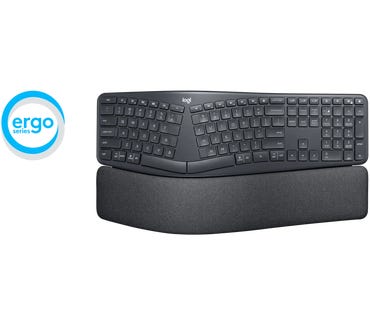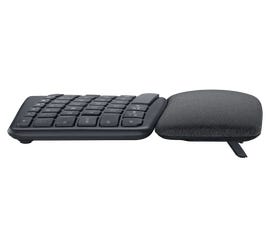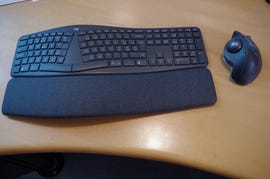BOOK THIS SPACE FOR AD
ARTICLE AD
Logitech Ergo K860 Keyboard.
Image: Logitech SAFinally (hooray!), Logitech has a "Natural" ergonomic keyboard widely available again.
I have been waiting literally several years for this, and I have worn out several of the previous K350 model – there are at least three in my storage room, with the letters worn off the keys, and there may well be one or two others around here.
I've had a K860 for a week or so now, and my impression so far is very good. The basic design is very different from the K350 (or from any other keyboard I have seen), so it might be a bit shocking or even disturbing when you first see and touch it. But as usual, it appears that Logitech has done their homework, done a lot of research into design and functionality, and come up with an innovative new product.
SEE: Hiring Kit: Computer Hardware Engineer (TechRepublic Premium)
The basic layout of the keyboard is typical for the "natural" or "ergonomic" type – the keys are split in the middle into two banks, and the entire unit is curved both horizontally and vertically. The padded wrist rest is integrated in the keyboard unit, and can not be removed from it. The key layout is pretty standard, with sections for the basic keyboard, editing and cursor keys, and a numeric keypad. However there are a few special keys which I will explain below.

K860 Tilt Legs.
Image: Logitech SAIn addition to sitting flat on your desk, there are retractable legs integrated in the wrist rest – and not just one set, but two with different lengths, which will give two different angles to the keyboard (-4 and -7 degrees). My experience so far has been that leaving it flat is the most comfortable way to work when I am sitting at my desk, but the maximum -7 degree tilt is much better when I am working at a standing desk.
The wrist rest is padded, but not overly so – it doesn't feel like an overstuffed pillow or a gel bag (both of which I really dislike).
The keys are thinner and have less travel than the K350 had, and I think they have a more solid feel and better tactile feedback when typing very quickly. There are a number of keys that have a special design or function, including:
The ESC key is huge. Really huge.The usual row of F1-F12 keys above the keyboard is followed by an Fn-lock key, which lets you switch the functionality between standard F1-F12 and dedicated function keys such as volume up/down/mute, brightness up/down, media play/reverse/stop and such.Connectivity keys, for pairing and selecting between different hosts.The "Windows" key is no more, it is labeled "Start", with no logo.There is an on/off switch and a power LED at the front center of the keyboard – the switch is very small, and located just under the front edge, so you might not even notice it, and the power LED only stays on for about 5 seconds after switching on.
Logitech Ergo K860 Wireless Ergonomic Keyboard
Comes with Wrist Rest
The K860 can be paired with up to three systems, via Bluetooth or the Logitech Unifying USB receiver. There are three "Easy-Switch" keys above the editing/cursor section of the keyboard, which you use to pair with and then select between hosts. Logitech provides software to configure and control all of this on Windows and Mac; if you are using the K860 on a Linux system, you will need to install the solaar package to control pairing and configuration.

Logitech K860 Keyboard and MX Ergo Trackball.
Image: J.A. WatsonIf you look at the Logitech web page, it seems like they are trying to push using the K860 along with the MX Vertical mouse (every picture that shows the keyboard on a desk has an MX Vertical next to it). There's even a question in the FAQ about whether a "desktop set" with the K860 and MX Vertical are available as a bundle (the answer given is "they are sold separately", but I have a feeling is should be "not yet"...). Personally, I am using it along with an MX Ergo trackball, both on the same Unifying receiver of course, and I think it is a perfect combination.
So there you have it, in a nutshell. After a week or so of use, I love it. If you are a "natural" keyboard user, I suspect that you will too.
.png)
 4 years ago
130
4 years ago
130 














 Bengali (Bangladesh) ·
Bengali (Bangladesh) ·  English (United States) ·
English (United States) ·